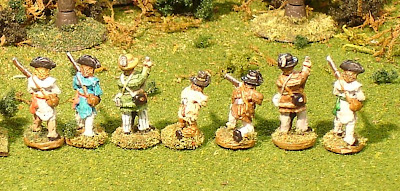"It will be, perhaps, proper here to mention, that we were a set of men acting entirely on our own footing, without the promise or expectation of any pay. There was nothing furnished us from the public; we furnished our own clothes, composed of course materials, and all home spun; our over dress was a hunting shirt, of what was called linsey woolsey, well belted around us. We furnished our own horses, saddles, bridles, guns, swords, butcher knives, and our own spurs."
He also described wearing a helmet which was designed to protect the head against the sword blows of mounted opponents (more on this in a future post). Sometimes, however, his dress amounted to a simple “hunting shirt and hat.”
Esteemed artist Don Troiani has painted a number of depictions of American riflemen. These works are consistent with Collins' description and numerous other sources of information.
Links to Troiani paintings:
Morgan's Rifle Corps, 1775
North Carolina militiaman, 1776
Carolina militiaman, 1780
A number of manufacturers of 15mm miniatures have versions of the American rifleman. I have painted to date miniature riflemen produced by Essex Miniatures, Freikorps Miniatures, Musket Miniatures, and Minifigs. Below I show the ones I've painted to date and comment on the relative strengths of each manufacturers' models.
The pack of Essex riflemen I purchased included men in three well-selected poses: kneeling at ready, running, and standing and firing. The Essex riflemen have the longest barrel of the four manufacturers, and their clothing and gear seems historically accurate. These miniatures are robustly 3-dimensional and their facial features have excellent definition.

 Essex Miniatures American Revolution riflemen (click to enlarge).
Essex Miniatures American Revolution riflemen (click to enlarge).

 Freikorps Miniatures American Revolution Riflemen (click to enlarge).
Freikorps Miniatures American Revolution Riflemen (click to enlarge).

 Musket Miniatures American Revolution Riflemen (click to enlarge).
Musket Miniatures American Revolution Riflemen (click to enlarge).
Minifigs riflemen come in one "running" pose. Packs include two officers, who are waving their rifle in one arm. The privates cannot be easily modified; one of the officers' arms can be bent without great difficultly. Overall, this is a good action pose, and the figure resembles Troiani's handsome painting of one of Morgan's riflemen. Like the Essex riflemen, these miniatures have well-selected gear and are robustly 3-dimensional. The lack of variety within a pack is the chief downside.

 Minifigs American Revolution Riflemen (click to enlarge).
Minifigs American Revolution Riflemen (click to enlarge).
Perhaps the best way to create historically-realistic variety in a unit is to mix miniatures from several lines. The miniatures from these four manufacturers are all approximately same height, however, the Musket Miniatures riflemen seem small compared to those by Minifigs. Because of the small bases on the Essex and Musket Miniature riflemen, I mounted them on thin Litko bases (in most cases, cut in half). This makes the Musket Miniatures figures seem tall and gangly look when they are placed alongside the others.


The Combined Riflemen (click to enlarge).
Sources:James Collins. (1859). Autobiography of a Revolutionary Soldier.
No comments:
Post a Comment